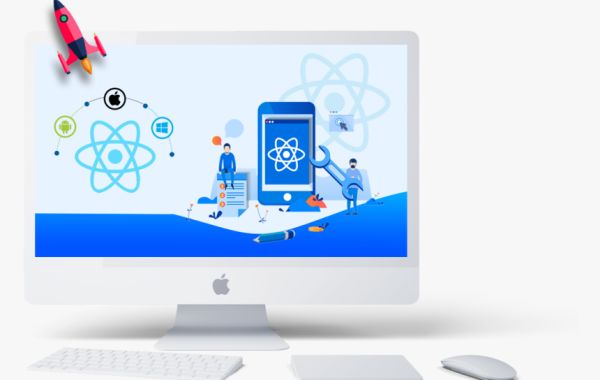React Native is an open-source tool for boosting business growth with cross-platform solutions. The React Native app mechanism uses three threads.
- UI thread (manipulates views),
- JS thread (rendering/ logics and behavior), and
- Background thread (layout computation).
It is a combination of JS, TypeScript, JSX, and React technologies. This delivers native-like performance and accelerates efficiency and flexibility.
The mobile app development company is adapting React Native for its code reusability, cross-platform efficiency, vast resources, and community base. In this blog, instead of discussing the main features, we’ll share the top React Native Development trends that will influence the industry in the upcoming time.
Top 7 Astonishing React Native Development Trends in Spotlight
React Native is a versatile, fast-paced tech stack that accelerates cross-platform development solutions. Developers with an innovative mindset focus on emerging trends and advancements to stir the growth potential of next-gen apps.
1. Adaption of Serverless Architecture
Infrastructure resources play a vital role in the app's design. As serverless architecture is introduced to the industry, developers can step ahead without concern for server maintenance and management. Amazon has a suite of tools and resources to flawlessly deploy and develop the application, eliminating bottlenecks and delays. Developers can avoid tedious tasks such as server management, hosting, or code management. AWS Amplify, Azure Functions, and Azure Lambda enable the server-less deployment cloud architecture to deploy scalable digital solutions.
2. AI, ML, and other Emerging Technologies
There is a plethora of emerging technologies booming in the diverse industry zones. However, they're still in the initial incorporation phase, as few span the avenues. Within the next five years, these technologies will bring an immersive experience beyond our imagination, driving more convenience, comfort, and efficiency.
AI, ML, AR/ VR, and predictive analytics are emerging as growth catalysts, supporting the business in planning future advancements with wise moves. It shreds off the load from developers, giving them new opportunities to innovate and launch smart and intuitive apps to deal with the most crucial real-life scenarios with automation. Adapt the React Native best practices to achieve a more personalized experience.
Also Read: React Native Cross-Platform Development: Best Strategies and Tips
3. Fabric: Rendering Architecture
In React Native's previous architecture, three threads were responsible for executing different mechanisms. With the release of this new legacy rendering system, app development will be more streamlined as it isolates the UI thread from the JS thread and enables the independent UI to make required changes. It reduces latency, enhancing interoperability. Furthermore, it has escalated the performance level, loading speed, and reliability of the React Native app.
Another feature of Fabric that is gaining attention in the developing world. It’s asynchronous rendering, which improves the user experience by prioritizing and focusing on user actions.
Access the React Native App Development Services to incorporate these advanced architecture capabilities into the app.
4. JSX: An Extension
This JS extension makes the DOM modest and less complex. It drives the convenience of writing HTML code in React applications. Alternatively, it offers the essence of HTML and JS as an extension. It improves performance by optimizing the code structure and displaying the flags for errors and warnings. In 2024, the developer community expects a transformation with new accessibility to make their server-side coding experience more enjoyable.
5. Concurrent mode
Concurrency mode is standard practice, eliminating the challenges of app development. The app involves intense rendering operations, which may impact its performance. The app may start lagging issues or crash down. To achieve responsiveness, rendering, and speed, it is one of the React Native App Development trends concepts. It establishes agility, faster rendering, and usability by prioritizing the actions and tasks, making the app highly responsive.
6. React Suspense for Data Fetching
React Suspense is a worthy implementation of React Native projects. It manages smooth data fetching and rendering for multiple components, optimizes server-side rendering, and proposes SEO capabilities to improve the user experience. It will gain popularity in 2024. Developers will also prioritize the GraphQL APIs for flexible data management.
7. Implementation of Recoil and Redux
These are two libraries for managing efficient communication and data transfer. They take a holistic approach to simplifying state management in complex app architecture, making the app scalable and easy to operate. Incorporate this React native development practice for more advanced level accessibility.
8. Static Typing with TypeScript
JS developers are familiar with the importance of TypeScript, which optimizes the quality and performance of the React native app. Thus, in 2024, developers will continue implementing static typing practices to drive code robustness, reliability, and flexibility.
We have reached the end of this post. In brief, in 2024, developers will focus on improving the user experience. They will incorporate best practices focusing on inclusive design, accessibility, and robust usability.
Get a Scalable App for Your Business Needs!
With the React Native App, you can expose your products and services to a wide base audience and reach out to multi-device users.
Wrap Up:
React Native is a prominent technology trend that empowers businesses with cross-platform apps. It will improve with the latest releases of APIs, architecture, plugins, and other resources. Such things would cater to development needs and deliver delightful experiences to developers and users. At Quokka Labs, we are adopting the transition to make smart apps that keep users engaged.






